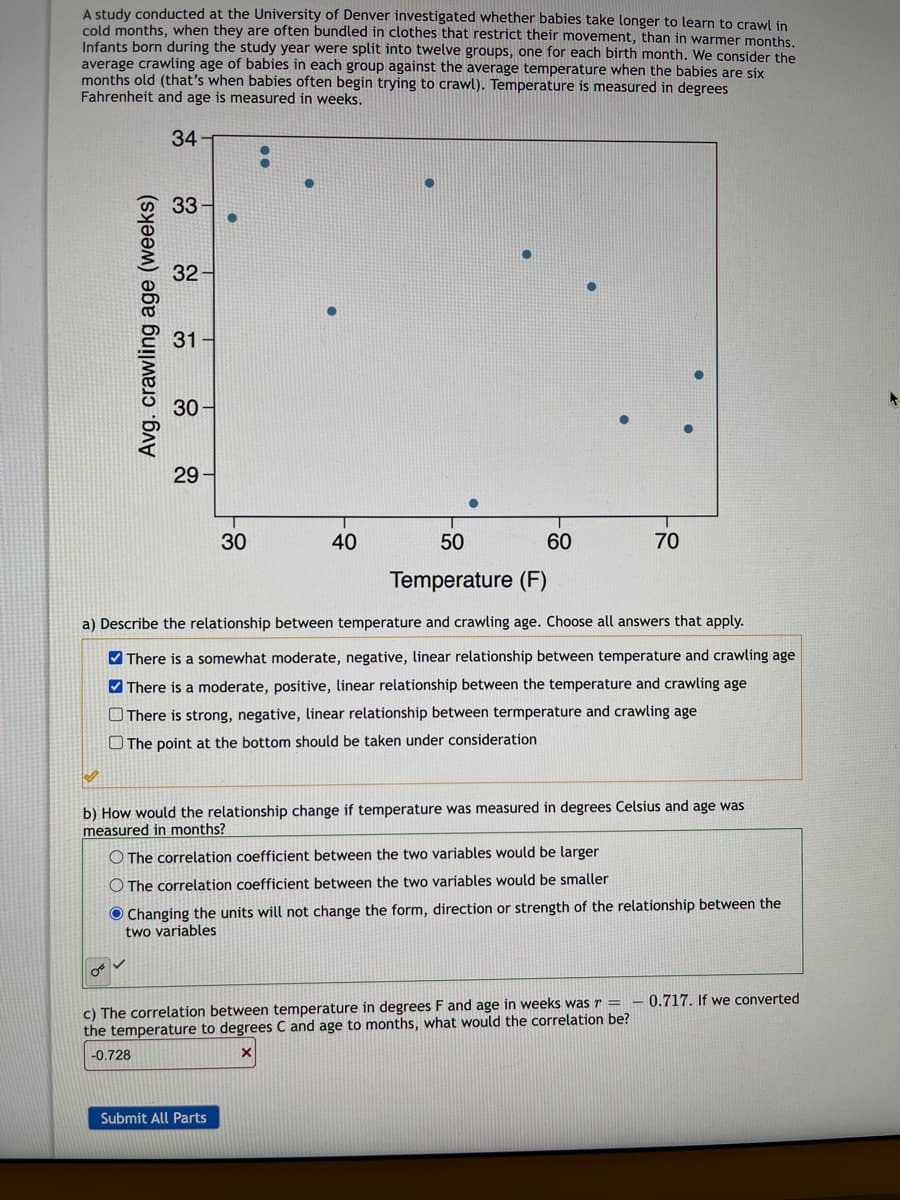A study conducted at the University of Denver investigated whether babies take longer to learn to crawl in cold months, when they are often bundled in clothes that restrict their movement, than in warmer months. Infants born during the study year were split into twelve groups, one for each birth month. We consider the average crawling age of babies in each group against the average temperature when the babies are six months old (that's when babies often begin trying to crawl). Temperature is measured in degrees Fahrenheit and age is measured in weeks. 34 Avg. crawling age (weeks) 33- 32- 31 30- 29- 30 ● 40 50 Temperature (F) a) Describe the relationship between temperature and crawling age. Choose all answers that apply. There is a somewhat moderate, negative, linear relationship between temperature and crawling age There is a moderate, positive, linear relationship between the temperature and crawling age There is strong, negative, linear relationship between termperature and crawling age The point at the bottom should be taken under consideration 60 Submit All Parts b) How would the relationship change if temperature was measured in degrees Celsius and age was measured in months? O The correlation coefficient between the two variables would be larger O The correlation coefficient between the two variables would be smaller 70 Changing the units will not change the form, direction or strength of the relationship between the two variables c) The correlation between temperature in degrees F and age in weeks was r = the temperature to degrees C and age to months, what would the correlation be? -0.728 0.717. If we converted
A study conducted at the University of Denver investigated whether babies take longer to learn to crawl in cold months, when they are often bundled in clothes that restrict their movement, than in warmer months. Infants born during the study year were split into twelve groups, one for each birth month. We consider the average crawling age of babies in each group against the average temperature when the babies are six months old (that's when babies often begin trying to crawl). Temperature is measured in degrees Fahrenheit and age is measured in weeks. 34 Avg. crawling age (weeks) 33- 32- 31 30- 29- 30 ● 40 50 Temperature (F) a) Describe the relationship between temperature and crawling age. Choose all answers that apply. There is a somewhat moderate, negative, linear relationship between temperature and crawling age There is a moderate, positive, linear relationship between the temperature and crawling age There is strong, negative, linear relationship between termperature and crawling age The point at the bottom should be taken under consideration 60 Submit All Parts b) How would the relationship change if temperature was measured in degrees Celsius and age was measured in months? O The correlation coefficient between the two variables would be larger O The correlation coefficient between the two variables would be smaller 70 Changing the units will not change the form, direction or strength of the relationship between the two variables c) The correlation between temperature in degrees F and age in weeks was r = the temperature to degrees C and age to months, what would the correlation be? -0.728 0.717. If we converted
Linear Algebra: A Modern Introduction
4th Edition
ISBN:9781285463247
Author:David Poole
Publisher:David Poole
Chapter2: Systems Of Linear Equations
Section2.4: Applications
Problem 28EQ
Related questions
Question
How do I solve the following problem?

Transcribed Image Text:A study conducted at the University of Denver investigated whether babies take longer to learn to crawl in
cold months, when they are often bundled in clothes that restrict their movement, than in warmer months.
Infants born during the study year were split into twelve groups, one for each birth month. We consider the
average crawling age of babies in each group against the average temperature when the babies are six
months old (that's when babies often begin trying to crawl). Temperature is measured in degrees
Fahrenheit and age is measured in weeks.
34
Avg. crawling age (weeks)
✔
33-
32-
31-
30-
29
30
40
50
Temperature (F)
a) Describe the relationship between temperature and crawling age. Choose all answers that apply.
There is a somewhat moderate, negative, linear relationship between temperature and crawling age
There is a moderate, positive, linear relationship between the temperature and crawling age
There is strong, negative, linear relationship between termperature and crawling age
The point at the bottom should be taken under consideration
60
Submit All Parts
70
b) How would the relationship change if temperature was measured in degrees Celsius and age was
measured in months?
O The correlation coefficient between the two variables would be larger
The correlation coefficient between the two variables would be smaller
Changing the units will not change the form, direction or strength of the relationship between the
two variables
c) The correlation between temperature in degrees F and age in weeks was r =
the temperature to degrees C and age to months, what would the correlation be?
-0.728
X
0.717. If we converted
Expert Solution
This question has been solved!
Explore an expertly crafted, step-by-step solution for a thorough understanding of key concepts.
This is a popular solution!
Trending now
This is a popular solution!
Step by step
Solved in 2 steps

Recommended textbooks for you

Linear Algebra: A Modern Introduction
Algebra
ISBN:
9781285463247
Author:
David Poole
Publisher:
Cengage Learning

Glencoe Algebra 1, Student Edition, 9780079039897…
Algebra
ISBN:
9780079039897
Author:
Carter
Publisher:
McGraw Hill

Mathematics For Machine Technology
Advanced Math
ISBN:
9781337798310
Author:
Peterson, John.
Publisher:
Cengage Learning,

Linear Algebra: A Modern Introduction
Algebra
ISBN:
9781285463247
Author:
David Poole
Publisher:
Cengage Learning

Glencoe Algebra 1, Student Edition, 9780079039897…
Algebra
ISBN:
9780079039897
Author:
Carter
Publisher:
McGraw Hill

Mathematics For Machine Technology
Advanced Math
ISBN:
9781337798310
Author:
Peterson, John.
Publisher:
Cengage Learning,